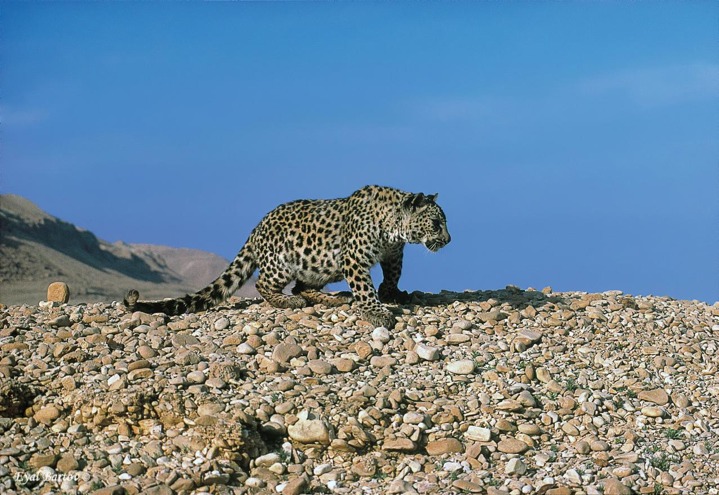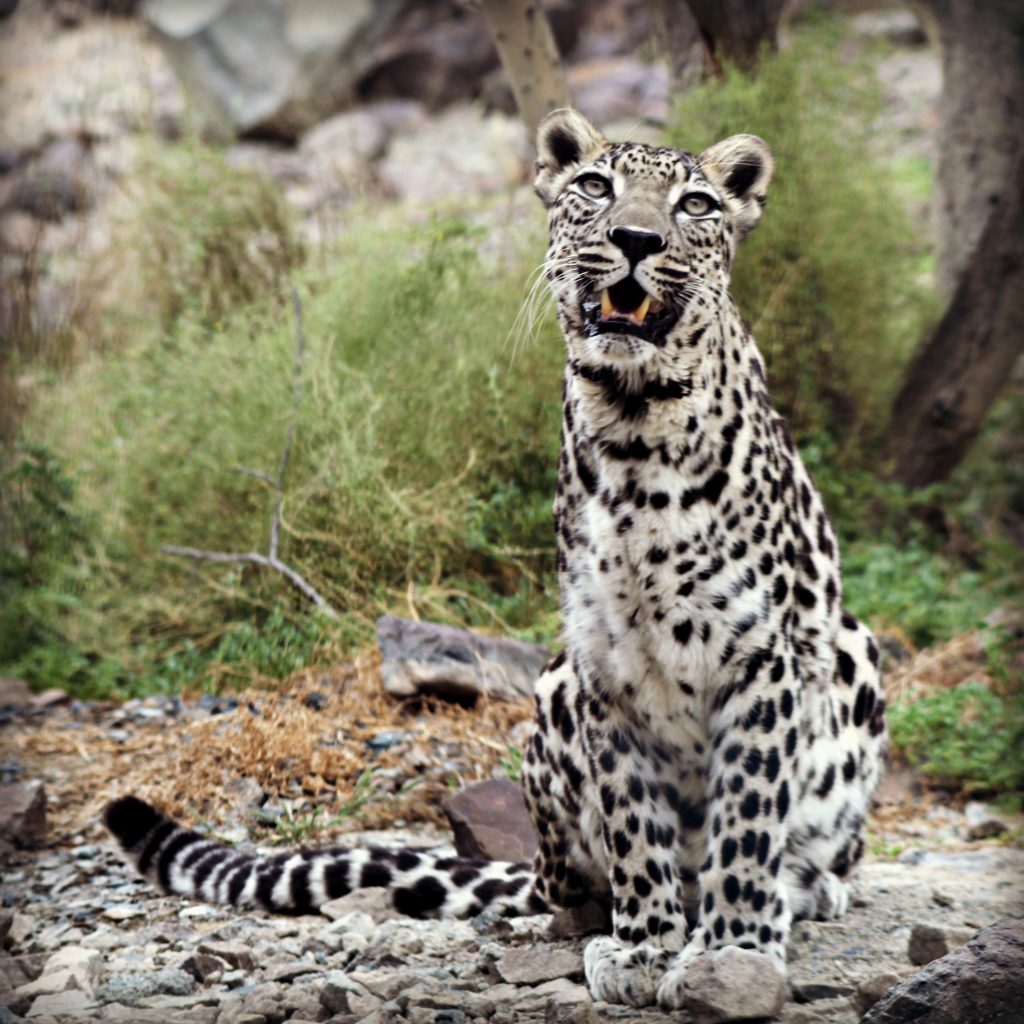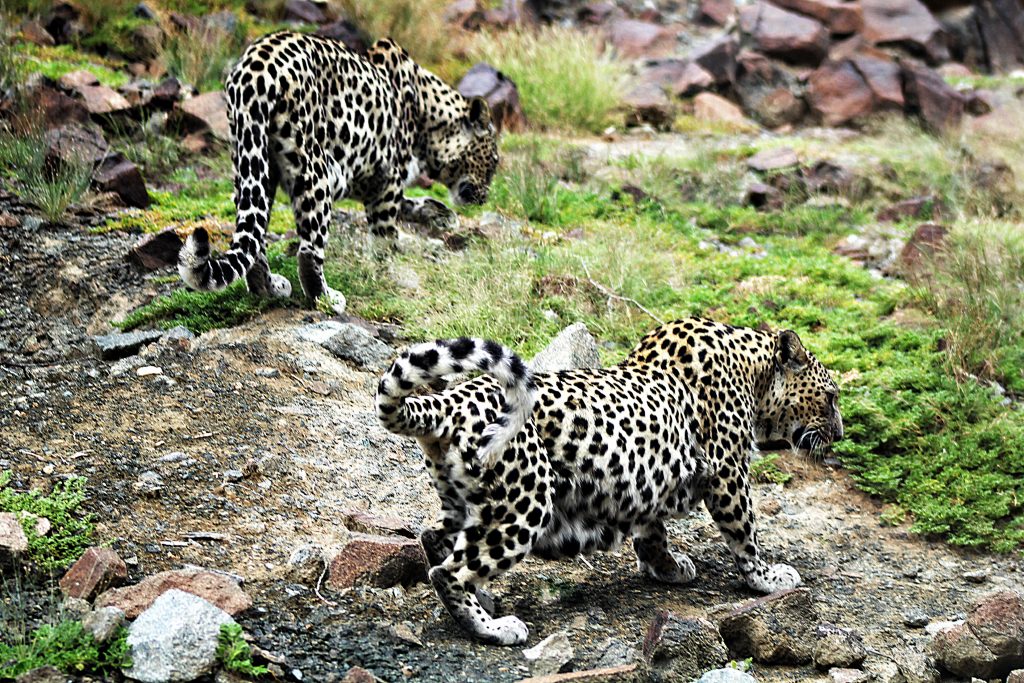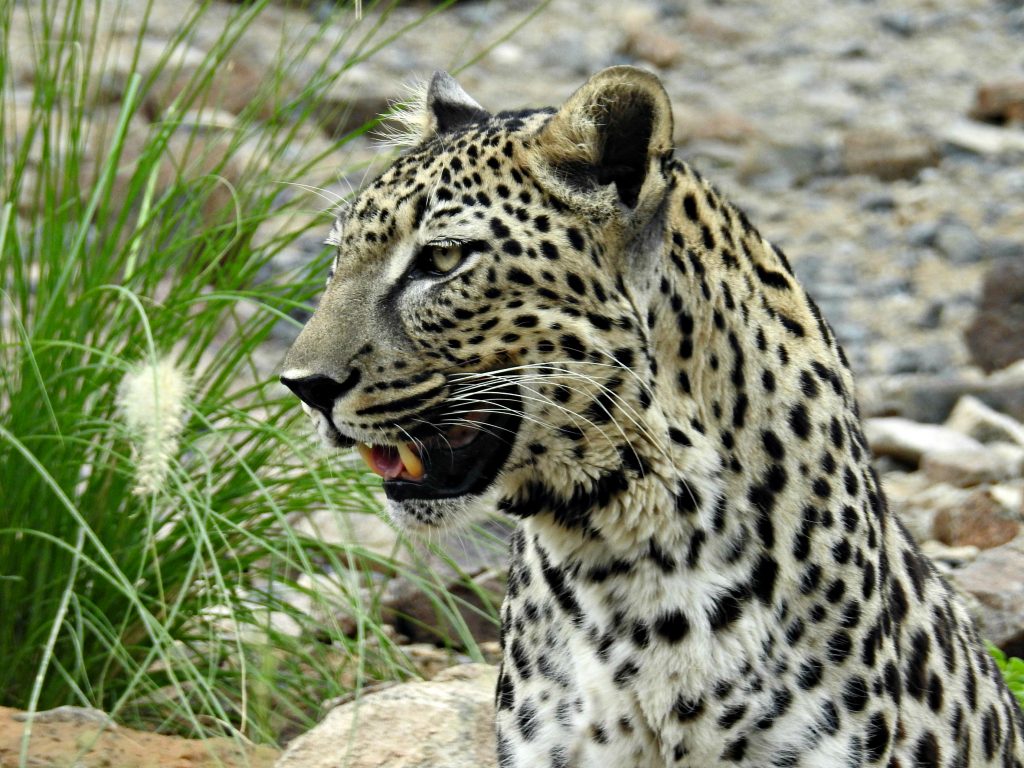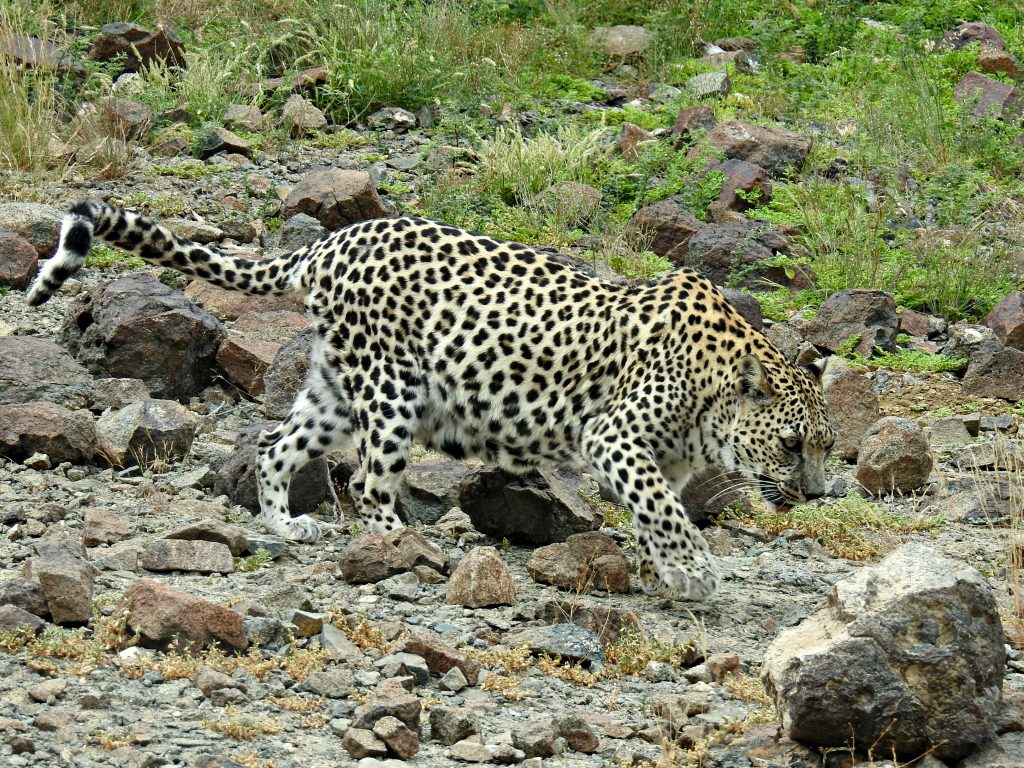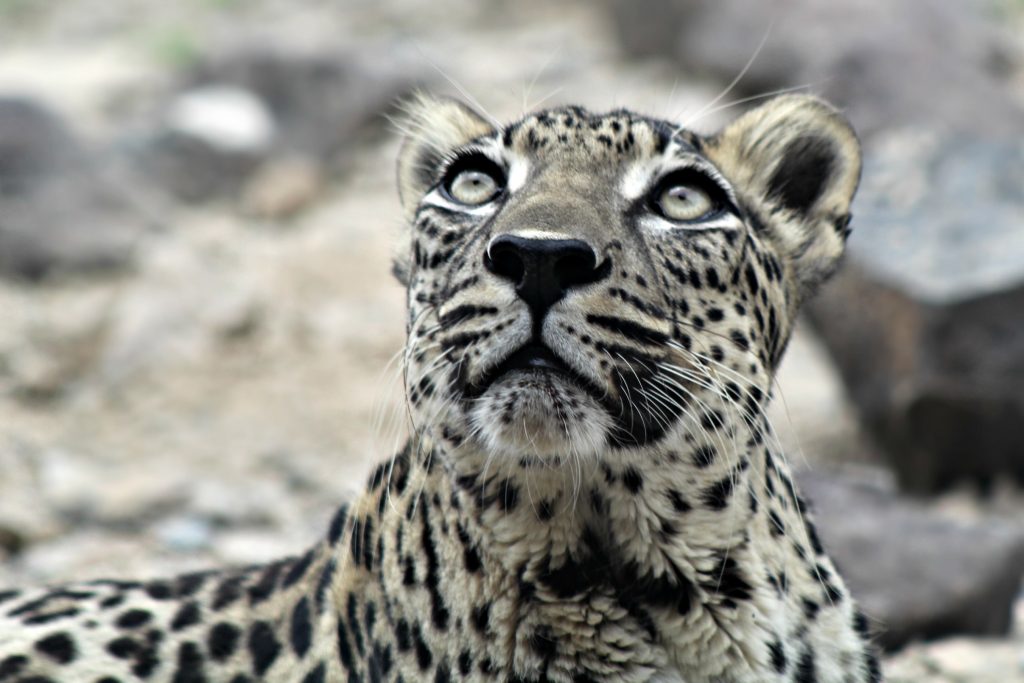Leopard, נמר, Panthera pardus
Back to FaunaLeopard
נמר (namer)
Panthera pardus
Image gallery
Biblical data
Introduction
The נמר, or leopard, is mentioned seven times in the Hebrew Bible. With one exception (Jer 13:23), the leopard always occurs as part of a list of predators, together with either a smaller carnivore, the זאב (wolf, Isa 11:1; Jer 5:6; Hab 1:8), or larger ones like lions and bears (Isa 11:16–8; Hos 13:7, שחל; Dan 7:1–8; Songs 4:8), as well as with the נשר (eagle, Hab 1:8) or snakes (Isa 11:8).
Distribution within the Bible
Five of the seven references to the leopard appear in prophecy. It occurs in a judgment prophecy in Hosea (13:7), twice in Jeremiah (5:6; 13:23), once in Habakkuk (1:8), and once in the utopian consolation prophecy in Isaiah (11:6–8). The line of threat is kept also in Daniel’s dream (Dan 7:1–8), as the leopard is third in line after the lion and the bear. Song of Songs (4:8) is the one occurrence in poetry.
Parts, Elements, Features that Are Specified in the Bible
The information one can gather from the seven occurrences in the Hebrew Bible contain references to the leopard’s habitat and its physiology (its spotted fur and its run), as well as its hunting strategies.
Habitat. The leopard’s habitat is referred to in Song of Songs (4:8) as being at the remote high mountains in the north of Israel, Senir and Hermon, where ממענות אריות מהררי נמרים, “from the dens of lions, from the hills of leopards.”[1] Yet leopards are looking for prey just outside human dwellings according to Jer 5:6. Indirectly, place names with the base נמר may further establish the prevalence of leopards in regions east of the Jordan; see נמרה in Num 32:3 and בית נמרה in Num 32:36; Josh 13:27 in the Israelite settlement of Gad, as well as מי נמרים in Moab (Isa 15:6; Jer 48:34).
Physiology.
-
Fur. The leopard is characterized by its spotted fur ונמר חברברתיו (Jer 13:23), which is said to be consistent from birth to its death and an identifying characteristic; see the zoological information.
-
Fast run. The leopard’s speed is behind the description in Hab 1:8: וקלו מנמרים סוסיו “Their horses are swifter than leopards.” Yet zoologists challenge that description and suggest that this specific quality better suits the cheetah (Acinonyx jubatus), otherwise known as the bardeles (pa¿rdaliß), which the LXX uses as the consistent equivalent of MT נמר; see History of Identification.
-
Laying down. The leopard is mentioned as “laying down” רבץ aside a גדי (kid, Isa 11:6).
Hunting strategies. The leopard is said to lie in wait outside city gates to capture its prey, which may be any humans going out of town: נמר שקד על עריהם כל היצא מהנה יטרף “A leopard lies in wait by their towns; whoever leaves them will be torn in pieces” (Jer 5:6). Leopards also lurk for prey on the main roads: כנמר על דרך אשור “Like a leopard I lurk on the way” (Hos 13:6).
Function in Context
All seven occurrences are metaphorical uses that build upon the leopard’s physiological characteristics and its predatory strategies and skills. In Song of Songs (4:8), the leopard symbolizes the remote and high places of its sojourn. As predator, the leopard symbolizes a human enemy equipped with battle horses (Hab 1:8) or even God as an enemy (Hos 13:7) who summons predators against his own people (Jer 5:6).
End Notes
[1] Amanah, Senir, and Hermon are hapax legomena in Song of Songs, while Lebanon occurs seven times in the scroll. Each of them individually and all of them together represent the most northern and remote mountain areas in Song of Songs; (Song 4:11, 15), the cedar among the trees of Lebanon (Song 3:9; 5:15), or the height of Lebanon (Song 7:5). Zakovitch (Song of Songs, 92) took them to stand for simply an exotic distant place. The general geography of Song of Songs is more commonly around the city of Jerusalem and the Judean desert, yet there is an observable tendency to mention remote places (Zakovitch, ibid., 29).
Bibliography
Zakovitch, Yair. Song of Songs. Mikra LeYisrael. Tel Aviv: Am Oved and Jerusalem: Magnes, 1992.
Contributor: Prof. Dalit Rom-Shiloni, DNI Bible Project Leader, Department of Biblical Studies, Tel Aviv University, Israel
History of Identification
Identification History Table
| Hebrew | Greek | Aramaic | Syriac | Latin | Arabic | English | |||||
| Ref | MT | LXX | Revisions | Targumim | Peshitta | Vulgate | Jewish | Christian | KJV | NRSV | NJPS |
| Isa 11:6 |
ונמר עם גדי ירבץ |
καὶ πάρδαλις συναναπαύσεται ἐρίφῳ |
ונמרא עם גדיא ישרי |
ܘܢܡ݂ܪܐ݂ ܥܡ ܓܕܝܐ ܢܪܒ݂ܥ |
et pardus cum hedo accubabit |
אלנמר
|
and the leopard shall lie down with the kid | the leopard will lie down with the goat
|
The leopard lie down with the kid | ||
| Jer 5:6 |
נמר שקד על עריהם |
καὶ πάρδαλις ἐγρηγόρησεν ἐπὶ τὰς πόλεις αὐτῶν |
יבזונונון שלטונין דחסינין כנמריא כמנין על קרויהון |
ܢܡ݂ܪ݂ܐ݁ ܢܟܡ݂ܢ ܥܠ ܩܘܪ̈ܝܗܘܢ. ܟ݂ܠ ܕܢܦܘܩ ܡܢܗܘܢ݂ ܢܬܬ݂ܒܪ |
pardus vigilans super civitates eorum omnis qui egressus fuerit |
אלנמר |
a leopard shall watch over their cities | A leopard is watching against their cities | A leopard lies in wait by their towns | ||
| Jer 13:23 |
ונמר חברברתיו |
καὶ πάρδαλις τὰ ποικίλματα αὐτῆς |
ונמרא שלטי רקמתיה |
ܘܢܡܪܐ ܟܟ̈ܠܬܗ݂
|
aut pardus varietates suas |
אלנמר |
or the leopard his spots? | or leopards their spots?
|
Or the leopard his spots? | ||
| Hos 13:7 |
כמו שחל וכנמר על דרך אשור |
καὶ ὡς πάρδαλις κατὰ τὴν ὁδὸν Ἀσσυρίων |
כליתא כנמרא דכמין על שבילא |
ܘܐܝܟ ܢܡܪ݂ܐ ܒܐܘܪܚܐ ܕܐ݁ܬܘܪ |
eis quasi leaena sicut pardus in via Assyriorum |
כנמר |
as a lion: as a leopard by the way will I observe them | like a leopard I will lurk beside the way
|
Like a leopard I lurk on the way | ||
| Hab 1:8 |
וקלו מנמרים סוסיו |
καὶ ἐξαλοῦνται ὑπὲρ παρδάλεις οἱ ἵπποι αὐτοῦ |
וקלילין מנמריא סוסותהון |
ܩ̈ܠܝܠܝܢ ܪ̈ܟܫܗ ܡܢ ܢܫܪ̈ܐ݂ |
leviores pardis equi eius et velociores lupis |
מן אלנמור |
Their horses also are swifter than the leopards | Their horses are swifter than leopards
|
Their horses are swifter than leopards | ||
| Song 4:8 |
ממענות אריות מהררי נמרים |
ἀπὸ μανδρῶν λεόντων, ἀπὸ ὀρέων παρδάλεων |
יתבי כרכין תקיפין דאינון גברין כאריון ותקרובתא מן קרוי טוריא דחסינין מן נמורים |
ܡܢ ܡܪܒܘܥܝܬܐ ܕܐܪ̈ܝܘܬܐ. ܘܡܢ ܛܘܪ̈ܝ ܢܡ݂ܪ̈ܐ
|
de cubilibus leonum de montibus pardorum |
מן ג׳באל אלנמור |
rom the lions’ dens, from the mountains of the leopards | from the dens of lions,
from the mountains of leopards
|
From the dens of lions, From the hills of leopards | ||
| Dan 7:6 |
וארו אחרי כנמר |
θηρίον ἄλλο ὡσεὶ πάρδαλιν |
ܐܝܟ ܢܡܪܐ |
quasi pardus |
מת׳ל אלנמר |
like a leopard | like a leopard
|
like a leopard | |||
Contributor: Prof. Dalit Rom-Shiloni, DNI Bible Project Leader, Department of Biblical Studies, Tel Aviv University, Israel
Life & Natural Sciences
ID
Arabian leopard
Class: Mammal
Order: Carnivore
Family: Felidae (cats)
Genus: Panthera
Species: Panthera pardus
Subspecies: Panthera pardus nimr
Nine subspecies of leopard are recognized around the world. In addition to the Arabian leopard, one is from Africa, the remainder inhabiting diverse parts of Asia (Stein et al. 2020). The Arabian leopard is one of the smallest subspecies. Its body mass ranges between 25‒30 kg, the male being much larger than the female (ca. 30‒32 kg vs. 23‒25 kg). Light yellow in color, it has a white abdomen and flanks (Mendelssohn & Yom-Tov 1999), its dark spots and rosettes contrasting with the color of the ground (Pennycuick & Rudnai 1970).
Sociality: Leopards are solitary animals. With the exception of mating and rearing cubs, each inhabits its own territory (Eisenberg & Lockhart 1972; Ilani 1980), which it marks by odor and (less frequently) vocally (Ilani 1980).
Activity period: Primarily during the night (nocturnal species). Leopards may also be active during the day, in particular when it is cool (Mendelssohn & Yom-Tov 1999; Shalmon 2015).
Diet: Ibex, gazelles, foxes, jackals, wild boars, hyrax, hares, porcupines, hedgehogs, and even rodents and birds (Mendelssohn & Yom-Tov 1999; Muir-Wright 1999).
Life History
Studies of leopards in the Judean Desert (e.g., Ilani 1980, 1990) indicate that the female leopard in this area gives birth every year. While cubs can be delivered all year around, the most common birthing period is spring. The gestation period lasts 3‒3.5 months, litters usually consisting of one or two cubs. In the Judean Desert, Arabian leopards reach sexual maturity between the ages of two and three, their estimated longevity being ca. 7 years (Stein et al. 2020). In captivity, they can live up to 27 years (Weigel 2005).
Characteristics that Appear in the Bible
Distribution and habitats: The leopard is one of the most widespread large-cat species, found in diverse habitats across most of Africa and Asia (Nowell & Jackson 1996) — forests, rainforests, savannas, shrubland, grassland, rocky areas, deserts/semi-desert regions, and snow-bound areas (Stein et al. 2020). Leopards exist both in mountainous environments (in the higher areas of Mount Kenya and the Himalayas — up to an altitude of 4,600 and 5,200 meters respectively) and lower slopes (the Judean desert — ca. 400 meters below sea level). The small populations of Arabian leopard are restricted to delimited areas of the Arabian Peninsula, Israel, and Jordan (Harrison & Bates 1991). Here, its habitats are mountainous and hilly landscapes (Harrison & Bates 1991). In Israel, the leopard was known in the Galilee, Judean and Negev Deserts, and probably also the Golan Heights and Hermon (Harrison & Bates 1991; Mendelssohn & Yom-Tov 1999; Perez et al. 2006).
Physiology
The spots: The leopard’s skin pattern functions as a form of camouflage, the combination of the white/yellow fur and brown/tan spots and rosettes mimicking the play between light and shadow in relatively open habitats such as savannahs. A permanent feature, it is unique to each individual, serving to identify individuals (Pennycuick & Rudnai 1970). Leopards living in arid climates have lighter fur than their relatives in humid areas. The leopards in northern Israel were thus darker than their counterparts in the south (Shalmon 2015).
Behavioral characteristics
Foraging strategy: Leopards are ambush predators: their eyes located in the front of their heads – enable them a three-dimensional vision. They thus detect their prey primarily by sight, complemented by smell and hearing (Shalmon 2015). Approaching their target stealthily, they attack from close quarters (Stander et al. 1997). While they bite larger prey in the throat, they bite smaller prey in the nape or puncture the skull with their canine teeth (Stein & Hayssen 2013).
Leopards near human settlements: Leopards have always lived in close proximity to human settlements (e.g., Prater 1965; Daniel 2009; Odden et al. 2014; Kshettry et al. 2018). This is known from India (Athreya et al. 2013), Africa (Stein et al 2020), and even Israel (Mendelssohn & Yom-Tov 1999; Paz 1998; Vidan, personal communication). Broad-ranging geographical evidence indicates that domestic animals — goats, cattle, and even cats and dogs — formed a common part of their diet (e.g., Perez et al. 2006; Athreya et al. 2014; Shehzad et al. 2014; Kshettry et al. 2018). Attacks on humans are not rare in some places (Athreya et al. 2016; Kshettry et al. 2017). One area of India, for example, witnesses 24 annual reports, none lethal (Kshettry et al. 2017). In Kashmir and Uganda, however, leopards are much more dangerous to human beings, the human mortality rate therein being 49% and 33% respectively (Treves & Naughton-Treves 1999; Nabi et al. 2009).
Leopard vs. cheetah: As presented in the History of Identification section, the LXX consistently translates נמר as πάρδαλις — i.e., cheetah (Acinonyx jubatus). This being the only context in which the cheetah occurs in the Hebrew Bible, the following passages provide zoological information concerning this predator.
ID
Cheetah
Hebrew: ברדלס, bardelas
Scientific name: Acinonyx jubatus
Class: Mammal
Order: Carnivore
Family: Felidae (cats)
Genus: Acinonyx
Species: Acinonyx jubatus
Only one species of cheetah is known, divided into five subspecies. The subspecies Acinonyx jubatus venaticus (commonly known as the Asiatic cheetah) is the only subspecies with a distribution outside Africa (Krausman & Morales 2005). In addition to its non-forested African habitat, the cheetah was earlier found in the Middle East, Central Asia, and across India (Caro 1994). Today, the only population outside Africa is the small Iranian population (Farhadinia 2004). In Israel, the cheetah became extinct in the late 1950s or ’60s (Dolev & Perevolotsky 2002). In Africa, the species has a body mass of ca. 35‒45 kg, the male being larger than the female (Caro 1994). Like the leopard, the species in Israel was most likely smaller. Light yellow or brown with small round black spots, its underparts are often white (Krausman and Morales 2005). This species also has unique tear-like marks from the inside of the eye to the outside of the mouth (Kitchener 1991). Little is known about the Asiatic cheetah or the population in Israel. The data provided herein thus relates primarily to the African cheetah.
Sociality: Adult females are solitary except when caring for their cubs. After the cubs leave their mother, they form a sibling group. When the females subsequently depart, the brothers remain together for the rest of their life (Caro 1994).
Period of activity: Mainly diurnal, hunting at dawn and dusk (Denis 1964).
Diet: The cheetah is an opportunistic predator. In Africa, its prey varies in size from small rodents and birds to large ungulates such as zebra and gnu (e.g., Myers 1975; Caro 1994; Marker et al. 2003). Its principal diet is gazelles (Gazella), impalas (Aepyceros melampus), other small- and medium-sized ungulates/the calves of large ungulates, however (e.g., Myers 1975; Mills et al. 2004). The Asiatic cheetah in Iran relies primarily on medium-sized ungulates — wild sheep (Ovis orientalis) and Persian ibex (Capra aegagrus) (e.g., Hunter et al. 2007; Farhadinia & Hemami 2010; Farhadinia et al. 2012). Although evidence exists of cheetah preying on domestic livestock in Africa and Iran, this is a relatively rare phenomenon (e.g., Marker et al. 2003; Wachter et al. 2006; Farhadinia et al. 2012).
The cheetah is found in open habitats in central India, Southwestern Asia, Arabia, and Africa (Kitchener 1991). In Israel, this open-habitat pattern is frequently in arid areas (Stuart & Stuart 1997) and other parts of the Mediterranean landscape (Ilani 1979).
Similar in size to the leopard (Acinonyx jubatus; ברדלס; also commonly called the “hunting leopard” [Strendale 1884; Krausman & Morales 2005]), but taller and slenderer, the two are frequently confused. In contrast to the leopard’s rosette pattern, the cheetah has solid circular spots and unique tear-like marks (Krausman & Morales 2005). Unlike the leopard, the cheetah is primarily diurnal, males and young females also living together in groups. Adapted to open habitats, the cheetah is the fastest terrestrial animal: when chasing prey, adult individuals can reach speeds of ca. 105 km/h (Schaller 1968).
Bibliography
Athreya, V., Odden, M., Linnell, J.D., Krishnaswamy, J., & Karanth, K.U. 2016. “A Cat among the Dogs: Leopard Panthera pardus Diet in a Human-dominated Landscape in Western Maharashtra, India.” Oryx 50(1): 156‒62.
Athreya, V., Odden, M., Linnell, J.D., Krishnaswamy, J., & Karanth, U. 2013. “Big Cats in our Backyards: Persistence of Large Carnivores in a Human-dominated Landscape in India.” PLOS One 8(3): https://journals.plos.org/plosone/article?id=10.1371/journal.pone.0057872
Athreya, V., Odden, M., Linnell, J.D.C., Krisnaswamy, J., & Karanth, U. 2014. “Letting a Cat Loose among the Dogs: Diet of Leopards in a Human-dominated Landscape in Western Maharashtra, India.” Oryx: 1–7.
Caro, T. 1994. Cheetahs of the Serengeti Plains: Group Living in an Asocial Species. Chicago: University of Chicago Press.
Daniel J.C. 2009. The Leopard in India: A Natural History. 2nd rev. ed. New Delhi: Natraj.
Denis, A. 1964. Cats of the World. Cambridge: Riverside.
Dolev, A., & Perevolotsky, A. 2002. Red Book of Threatened Species in Israel: Vertebrates. Jerusalem: Nature and Parks Authority/Society for the Protection of Nature in Israel.
Eisenberg, J.F., & Lockhart, M. 1972. “An Ecological Reconnaissance of Wilpattu National Park, Ceylon.” Smithsonian Contributions to Zoology 101: 1–118.
Farhadinia, M., & Hemami, M.R. 2010. “Prey Selection by the Critically-endangered Asiatic Cheetah in Central Iran.” Journal of Natural History 44(19‒20): 1239‒249.
Farhadinia, M. 2004. “The Last Stronghold: Cheetah in Iran.” Cat News 40: 11‒14.
Farhadinia, M.S., Hosseini-Zavarei, F., Nezami, B., Harati, H., Absalan, H., Fabiano, E., & Marker, L. 2012. “Feeding Ecology of the Asiatic Cheetah Acinonyx jubatus venaticus in Low-prey Habitats in Northeastern Iran: Implications for Effective Conservation.” Journal of Arid Environments 87: 206‒11.
Harrison D.L., Bates P.J.J., eds. 1991. “Felidae.” Pages 156-172 in The Mammals of Arabia. 2nd ed. D.L. Harrison & P.J.J.Bates. Sevenoaks: Harrison Zoological Museum.
Hunter, L., H. Jowkar, H. Ziaie, G. Schaller, G. Balme, C. Walzer, S. Ostrowski, P. Zahler, N. Robert-Charrue, K. Kashiri, and S. Christie. 2007. “Conserving the Asiatic Cheetah in Iran: Launching the First Radio-telemetry Study.” Cat News 46(8): 8‒11.
Ilani, G. 1979. Zoogeography and Ecology Survey of Carnivores in Israel. Jerusalem: Nature Reserves Authority.
Ilani, G. 1980. “The Leopards of the Judean desert.” Israel Land and Nature 22(3): 106‒16 (Hebrew).
Ilani, G. 1990. “Leopard Panthera pardus in Israel.” Cat News 12: 4–5.
Kitchener, A. 1991. The Natural History of the Wild Cats. London Christopher Helm.
Krausman, P.R., and S.M. Morales. 2005. “Acinonyx jubatus.” Mammalian Species 2005(771): 1‒6.
Kshettry, A., S. Vaidyanathan, and V. Athreya. 2017. “Leopard in a Tea-cup: A Study of Leopard Habitat Use and Human-Leopard Interactions in North-eastern India.” PLOS One 12(5): https://journals.plos.org/plosone/article?id=10.1371/journal.pone.0177013
Kshettry, A., S. Vaidyanathan, and V. Athreya. 2018. “Diet Selection of Leopards (Panthera pardus) in a Human-use Landscape in North-Eastern India.” Tropical Conservation Science 11: 1‒9.
Marker, L.L., J.R. Muntifering, A.J. Dickman, M.G.L. Mills, and D.W. Macdonald. 2003. “Quantifying Prey Preferences of Free-ranging Namibian Cheetahs.” South African Journal of Wildlife Research 33(1): 43‒53.
Mendelssohn, H., and Y. Yom-Tov. 1999. Mammalia of Israel. Jerusalem: Israel Academy of Sciences and Humanities.
Mills, M.G.L., L.S. Broomhall, and J.T du Toit. 2004. “Cheetah Acinonyx jubatus Feeding Ecology in the Kruger National Park and a Comparison across African Savanna Habitats: Is the Cheetah only a Successful Hunter on Open Grassland Plains?” Wildlife Biology 10(1): 177‒86.
Muir-Wright, M.T. 1999. “The Diet of the Highly Endangered Arabian leopard (Panthera pardus nimr).” BSc (Hons.) Thesis, University of Aberdeen.
Myers, N. 1975. “The Cheetah Acinonyx jubatus in Africa.” International Union of the Conservation of Nature Monograph 4: 9‒90.
Nabi, D.G., S.R. Tak, K.A. Kangoo, and M.A. Halwai. 2009. “Comparison of Injury Pattern in Victims of Bear (Ursus thibetanus) and Leopard (Panthera pardus) Attacks: A Study from a Tertiary Care Center in Kashmir.” European Journal of Trauma and Emergency Surgery 2: 153‒58.
Nowell, K., and P. Jackson. 1996. “Wild Cats: Status Survey and Conservation Management Plan.” IUCN/SSC Cat Specialist Group, Gland, Switzerland.
Odden, M., V. Athreya, S. Rattan, and J.D.C Linnell. 2014. “Adaptable Neighbours: Movement Patterns of GPS-collared Leopards in Human-dominated Landscapes in India.” PLOS One 9(11): https://www.researchgate.net/publication/268210312_Adaptable_Neighbours_Movement_Patterns_of_GPS-Collared_Leopards_in_Human_Dominated_Landscapes_in_India
Paz, U. 1998. “Gevan yarok ve-hom: Shmurat Ein Gedi.” Ha-hevra le-heker ha-adam ve-ha-sovev 36 (Hebrew).
Pennycuick, C.J., and J. Rudnai. 1970. “A Method of Identifying Individual Lions Panthera leo with an Analysis of the Reliability of Identification.” Journal of Zoology 160(4): 497‒508.
Perez, I., E. Geffen, and O. Mokady. 2006. “Critically Endangered Arabian Leopards Panthera pardus nimr in Israel: Estimating Population Parameters using Molecular Scatology.” Oryx 40(3): 295‒301.
Prater, S.H. 1965. The Book of Indian animals. Vol. 2. Bombay: Natural History Society.
Schaller, G.B., 1968. “Hunting Behaviour of the Cheetah in the Serengeti National Park, Tanzania.” African Journal of Ecology 6(1): 95‒100.
Shalmon B. 2015. My Desert. Eilat: Shalmon (Hebrew).
Shehzad, W., M.A. Nawaz, F. Pompanon, E. Coissac, T. Riaz, S.A. Shah, and P. Taberlet. 2014. “Forest without Prey: Livestock Sustain a Leopard Panthera pardus Population in Pakistan.” Oryx 49(2): 248‒53.
Stander, P.E., P.J. Haden, I.I. Kaqece, and I.I. Ghau. 1997. “The Ecology of Asociality in Namibian Leopards.” Journal of Zoology 242(2): 343‒64.
Stein, A.B., V. Athreya, P. Gerngross, G. Balme, P. Henschel, U. Karanth, D. Miquelle, S. Rostro-Garcia, J.F. Kamler, A. Laguardia, I. Khorozyan, and A. Ghoddousi. 2020. “Panthera pardus (amended version of 2019 assessment).” IUCN Red List of Threatened Species 2020: e.T15954A163991139: https://dx.doi.org/10.2305/IUCN.UK.2020-1.RLTS.T15954A163991139.en
Sterndale, R.A. 1884. Mammalia of India and Ceylon. New Delhi: Himalayan Books.
Treves, A., and L. Naughton-Treves. 1999. “Risk and Opportunity for Humans Coexisting with Large Carnivores.” Journal of Human Evolution 36: 275‒82.
Wachter, B., O. Jauernig, and U. Breitenmoser. 2006. “Determination of Prey Hair in Faeces of Free-ranging Namibian Cheetahs with a Simple Method.” Journal of Wildlife Research 33: 43‒53.
Weigl, R. 2005. Longevity of Mammals in Captivity: From the Living Collections of the World. Kleine Senckenberg-Reihe 48. Stuttgart: E. Schweizerbart’sche Verlagsbuchhandlung.
Contributor: Dr. Enav Vidan, Zoologist, Ecologist and Conservation Biologist, Tel Aviv University

